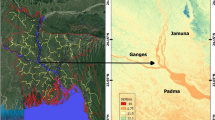Abstract
This study is to evaluate the impact of bank lines shifting on land use and land cover changes. It is also to understand the coherence between changes in land use and land cover and annual rate of river bank failure. To fulfill the purpose of the present study, 21 river bank erosion-affected mouzas along the banks of river Ganga-Bhagirathi in Jangipur subdivision of Murshidabad district, West Bengal, have been selected. The whole work has been done with the help of RS and GIS techniques. Field visit has been arranged to verify the ground truth basically. The result of the study shows that an area with active bank erosion problem is characterized by remarkable land use land cover changes. In the study area, total erosion is 7.93 square kilometer (km2) where the total deposition is 3.244 km2 along the river banks from the year of 1980 to 2010. It can be said that bank failure directly affects the land use and land cover of the area under the river channel. During 1980–1990, negative and significant correlation is observed between the annual rate of bank erosion and change in area under sparse vegetation (r = − 0.810). Again, positive and significant correlation is observed between the annual rate of bank erosion and change in area of water body (r = 0.60). Same scenario is also observed in the respective years of 1990–2000 and 2000–2010. Ganga-Bhagirathi bank erosion has an adverse impact on the dwellers of the flood plain.














Similar content being viewed by others
References
Chakrabarti, P., & Nag, S. (2015). River of West Bengal changing scenario. West Bengal: Geoinformatic and Remote Sensing Cell West Bengal State Council of Science and Technology, Govt. of West Bengal.
Charlton, R. (2008). Fundamentals of fluvial Geomorphology. London: Routledge.
Chatterjee, S., & Mistri, B. (2013). The impact of river bank erosion on human life: a case study in Santipur Block, Nadia District, West Bengal. International Journal of Humanities and Social Science Invention,2(8), 108–111.
Das, T. K., Halder, S. K., Gupta, I. D., & Sen, S. (2014). River bank erosion induced human displacement and its consequences. Living Reviews in Landscape Research. https://doi.org/10.12942/lrlr-2014-3.
Debnath, J., Das, N., Ahmed, I., & Bhowmik, M. (2017). Channel migration and its impact on landuse/landcover using RS and GIS: a study on Khowai River of Tripura, North-East India. The Egyptian Journal of Remote Sensing and Space Sciences. https://doi.org/10.1016/j.ejrs.2017.01.009.
Dragiccevic, S., Zivkovic, N., Roksandic, M., Kostadinov, S., Novkovic, I., Tosic, R., et al. (2012). Landuse changes and environmental problems caused by bank erosion: A case study of the Kolubara river basin in Serbia. In S. A. Opoku (Ed.), Environmental landuse planning (1st ed., pp. 3–20). London: Intechopen. https://doi.org/10.5772/50580.
Flood Preparedness and Management Plan (FPMP), Murshidabad. (2014). Government of West Bengal, West Bengal, India.
Gaur, A. S., & Gaur, S. S. (2009). Statistical methods for practise and research: A guide to data analysis by using SPSS. India: Sage Publications India Pvt Ltd. https://doi.org/10.4135/9788132108306.
Ghosh, D., & Sahu, A. S. (2018). Problem of river bank failure and the condition of the erosion victims: a case study in Dhulian, West Bengal, India. Regional Science Inquiry,10(2), 205–214.
Guite, L. T. S., & Bora, A. (2016). Impact of river bank erosion on landcover in lower Subansiri River Flood plain. International Journal of Scientific and Research Publications,6(5), 480–486.
Kar, N. S., & Bandyopadhyay, S. (2015). Tropical strom Aila in Gosaba block of Indian Sundorban: Remote sensing based assessment of impact and recovery. Geographical Review of India,77(1), 40–50.
Laha, C., & Bandyopadhyay, S. (2013). Analysis of the changing morphometry of River Ganga, shift monitoring and vulnerability analysis using space-borne techniques: A statistical approach. International Journal of Scientific and Research Publications,3(7), 1–10.
Lu, D., Mausel, P., Brondízio, E., & Moran, E. (2004). Change detection techniques. International Journal of Remote Sensing. https://doi.org/10.1080/0143116031000139863.
Mahmood, A. (2008). Statistical methods in Geographical studies. Delhi: M. L. Gupta, Rajesh publications.
Pal, S. K. (1998). Statistics for geo-scientists: Techniques and applications. New Delhi: Concept Publishing Company.
Rabbi, H., Saifullah, A. S. M., Sheikh, M. S., Sarkar, M. M. H., & Bhowmick, A. C. (2013). Recent study on river bank erosion and its impact on land displaced people in Sirajgoni riverine area of Bangladesh. World Journal of Applied Environmental Chemistry,2(2), 36–43.
Rudra, K. (1996). Problems of river bank erosion along Ganga in Murshidabad district of West Bengal, India. Journal of Geography and Environment,1, 25–32.
Rudra, K. (2006). Shifting of the Ganga and land erosion in West Bengal/A socio-ecological viewpoint. West Bengal: Indian Institute of Management Calcutta.
Sarkar, A. (2012). Practical geography: A systematic approach. Kolkata: Orient Black Swan Private Limited.
United Nations Developmental Programme. (2004). Reducing disaster risk a challenge for development, A Global report, UNDP bureau for crisis prevention and recovery, NewYork. http://www.planat.ch/fileadmin/PLANAT/planat_pdf/alle_2012/20012005/Pelling__Maskrey_etal_2004.
Yang-chun, F., Yan-chun, H., & Xiu-min, M. (2017). The application of student’s t-test in internal quality control of clinical laboratory. Frontiers in Library Medicine. https://doi.org/10.1016/j.flm.2017.09.002.
Acknowledgements
The authors thank the editor-in-chief for acceptance of the paper and to the reviewers for their valuable comments for the up gradation of this research paper. We are also greatly thankful to the DST-PURSE II programme, University of Kalyani, Kalyani, Nadia-741235 for also some financial assistance in the processing of the research paper. We are greatly thankful to GLCF for providing the satellite images and also to the District Land and Land Reform Officer, Murshidabad, West Bengal, for providing mouza maps.
Author information
Authors and Affiliations
Corresponding author
Additional information
Publisher's Note
Springer Nature remains neutral with regard to jurisdictional claims in published maps and institutional affiliations.
About this article
Cite this article
Ghosh, D., Sahu, A.S. Bank Line Migration and Its Impact on Land Use and Land Cover Change: A Case Study in Jangipur Subdivision of Murshidabad District, West Bengal. J Indian Soc Remote Sens 47, 1969–1988 (2019). https://doi.org/10.1007/s12524-019-01043-0
Received:
Accepted:
Published:
Issue Date:
DOI: https://doi.org/10.1007/s12524-019-01043-0




